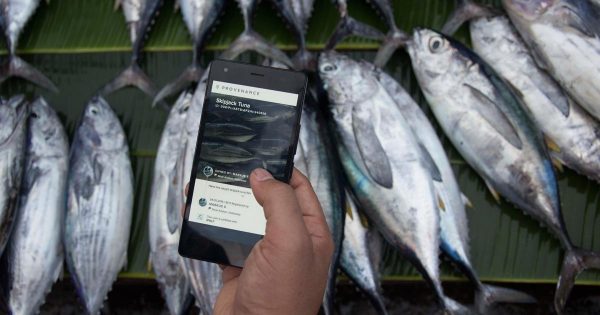Emerging technology was a recurring theme at the International Summit of Co-operatives in Quebec last month, where delegates looked at how it can be used by co-ops.
“With social media it is possible for a new generation of co-ops to move quickly if they have a new idea,” economist Jeremy Rifkin told delegates. “And co-operatives have the industries, the people and the appropriate form – democratic, open, distributive, transparent – to distribute it.”
Because of this, “co-ops will be the ideal venue to scale the digital revolution,” he said.
One of the key players in this revolution is blockchain technology, which allows digital transactions to take place with full trust between parties, without the need for human interaction.
How does it work?
“A blockchain is a public, tamper-proof record of transactions which is maintained and verified by a network of co-operating computers, rather than by a central authority like a bank,” says the team at CoopDigital, the digital department of the Co-op Group.
“The oldest and best-known blockchain application is the digital currency Bitcoin, a decentralised digital currency in which the transactions are between (anonymous) individuals rather than via an intermediary such as a bank or Visa.
“It’s a decent medium of exchange (you can buy quite a lot of of things with it) but a volatile store of value (it goes up and down a lot in value against other currencies).”
In money terms, the blockchain replaces the credit ledger functions of a central bank, and in contractual terms, a blockchain might replace a court.

“In a blockchain, participants may be anonymous or pseudonymous, in that there is no person or activity that verifies who the people in the transaction are,” says CoopDigital.
“Transactions are public – which is a key point for applicability in business – but in order to validate the transactions, computers have to perform a proof of work, which is a complex bit of cryptographic maths.”
Mathematical scrambling is used to convert an original piece of information into a code, known as a hash. Any attempt to tamper with any part of the blockchain is apparent immediately – because the new hash will not match the old ones.
“Once a computer finds a solution to the problem, it broadcasts it to the network, and the rest of the network verifies the solution,” says CoopDigital. “This prevents, for example, someone spending the same money twice.”
The CoopDigital team says the beauty of blockchains is that they are both tamper proof – thus providing better accountability and making fraud almost impossible – and distributed.
“There is no reliance on middle men to provide key infrastructure, account for transactions or arbitrate disputes – or be corrupt.”
This is turn has other effects, such as lower costs.
Additionally, blockchain-based currencies may fill a gap for countries with under-developed banking systems, as the proof of work mechanism authenticates the user in an anonymous, relatively tamper-proof way, adds the CoopDigital team.
As programme development lead at Co-operatives UK, Simon Borkin has been exploring how the blockchain model could support growth in the co-op sector.
“Databases and registers are fairly commonplace in every walk of life,” he says, “and as we move to our more digital and data-driven society, blockchain presents an opportunity for automation and trust to be applied to an activity which requires significant administration and can be open to abuse.
“As an organisational innovation, it seems very aligned with co-operative structures. However like any new technological advances, its value will also depend on wider cultural acceptance.”
The early adopters are in the platform co-op movement, he says, “which makes sense as the practitioners in this space are driven by an interest in tech and co-operative structures, so are more open to such practices.
“The ability for it to mainstream will depend on more sociological factors and public acceptance of such a technology.”
One example, he says, is Backfeed (backfeed.cc), a social operating system for decentralised organisations, “which enables massive open-source collaboration without central coordination”.
Another is the Robin Hood Co-operative, a Finland-based activist hedge fund that uses financial technologies to democratise finance, expand financial inclusion and generate new economic space.
How can it be used?
Borkin believes the unique application for co-operatives is how blockchain might enable distributed and decentralised governance for organisations in which membership is dispersed.
“In a digital age, co-operatives are going to have to find new ways to allow member participation and decision-making in a time when it can be culturally and geographically more difficult to bring people together physically.
“Equally effective mutual governance often relies on building trust between and across members, which is much easier when you can physically interact. Blockchain provides a trust mechanism for many operational activities around decision making, finance and record keeping, without the need for close physical proximity.”
Co-operatives, like other businesses, are exploring how blockchain can be applied to support commercial operations.
In America, the Credit Union National Association (CUNA) and Mountain West Credit Union Association (MWCUA) are leading the CU Ledger blockchain project, which brings together 56 credit unions and four of the largest credit union service organisations to explore the creation of a distributed shared ledger for credit union.
Rich Meade, chief of staff and chief operating officer at CUNA, believes the project will work due to the co-operative nature of credit unions.
“The two basic [blockchain] concepts are scale and security, and we have credit unions representing enough members so that when we get this going we should be able to scale quickly,” he said.
In the UK, the Co-op Group is trialling blockchain to help ensure produce is being sourced sustainably.
“The Co-op has always been a leader when it comes to championing the customer’s right to food that is formulated, manufactured and marketed in a way they can trust,” says Cathryn Higgs, head of food policy at the retailer.
“We also believe that everyone deserves to be treated fairly and take seriously our commitment to improving the lives of people in the communities we trade with.
“Openness, honesty and social responsibility are part of our ethical values and we have a long history of taking action to support customers right to know about how the products they buy are made and sourced so that they can make an informed purchasing decision and the best choice for them personally.”

The Group has set up a partnership with Provenance.org (read the case study below), a start-up social enterprise which uses blockchain technology to enable transparency of data and verification of claims in supply chains, in order to tell verifiable stories about where food comes from and how it gets from source to shop shelves.
Jessi Baker, founder and CEO of the start-up, says Provenance is “like Fairtrade for the digital age”.
“We’re not trying to be another certification,” she adds. “What we’re trying to be is a common method of access to the journey of items and to prove key claims on items labels.
“For brands, proving key claims about a product – backed up by verification that everyone is able to see – will be a key competitive advantage in future.”
What are the drawbacks?
As exciting as blockchain is, it isn’t a magical band aid that can immediately fix all digital ills.
“The real struggle is moving from the old to the new,” said Jeremy Rifkin at the International Summit.
“New ideas are moving through quickly. Financial services industries are disrupted and can either adapt or disappear. Co-op banks should be at the forefront of transforming industry, just as in electricity, where co-ops have already transformed the sector.”
He also spoke about data compromisation. “Data security is an issue,” he warned. “Technology has had a dark time, there is a need to build resilience into the system.”
“Similar to other innovations, blockchain began life in a niche space (cryptocurrencies) and so the value of it as a wider application is yet to be fully realised,” says Simon Borkin.
“There have already been instances where blockchain has been ‘hacked’ or compromised and, given its infancy, it’s too early to tell whether its ability to be manipulated is an inherent flaw or indicative of an emerging technology which is becoming more robust.”
The team at CoopDigital also says there are some drawbacks, which could affect its implementation such as the time and computer power needed to validate transactions. There is an issue of governance, too; currently the Bitcoin community disagrees over whether to add new features, and is effectively splitting into two currencies.
While he believes blockchain is powerful, Rich Bartlett, co-founder of Loomio, a platform co-operative which facilitates democratic online decision making, says the technology is both frustrating and hasn’t been used to its full potential.
“I’m interested in what technology can do to help us organise in better ways, to get around corruption and provide transparency,” he said. “However I’ve found that conversations around blockchain have been infuriatingly naive – they don’t look at the history of decentralising power, there’s no connection to civil rights movements, feminist movements, and other radical movements.
“There is a role of blockchain, but it needs to learn from power struggles and critical theory too.”
Case study: Tracking Tuna on the blockchain…
Provenance recently completed a six-month pilot using blockchain technology to trace yellowfin and skipjack tuna fish in Indonesia, from catch to consumer.

“The goal was to aid robust proof of compliance to standards at origin and along the chain … and explore how these new technologies could form the basis for an open system for traceability powering consumer-facing transparency for food and other physical goods,” said a report into the project.
“The pilot was successful in tracking responsibly caught fish and key social claims down the chain to export. Provenance’s ambition was not to demonstrate yet another digital interface, but a solution to tracking items and claims securely, end-to-end, in a highly robust, yet accessible format without the need for a centralised data management system.”
Fishermen registered their catch by text message, thus issuing a new asset on the blockchain which was then transferred from fisherman to supplier along with the catch. The social and environmental conditions for the fishermen at the point of capture are verified through trusted local NGOs.
The pilot then explored how the blockchain could be linked with existing systems, looked at how the information from origin and the supply chain could be reached and trusted by shoppers. Provenance conducted a workshop and in-store prototyping session with Bighton-based Hisbe supermarket, a community interest company.
“The workshop provided significant insights on consumer behaviour, influencing ideas for how Provenance technology could best manifest in a supermarket scenario. The resulting strategy: to replace the clutter of traditional printed communication with Provenance online stories and journeys, accessible via in-store tablets and NFC-enabled smart stickers.
“On the tablets, shoppers can view stories for each product range, seeing the producers and suppliers involved in farming or processing. Through smart stickers and packaging, shoppers can hover their smartphones over a product to track its provenance right on their screens. This system empowers a new era of more conscientious, trusting consumers willing to pay more for products with proven origins.”
- Read the full report at: provenance.org/tracking_tuna_on_the_blockchain

